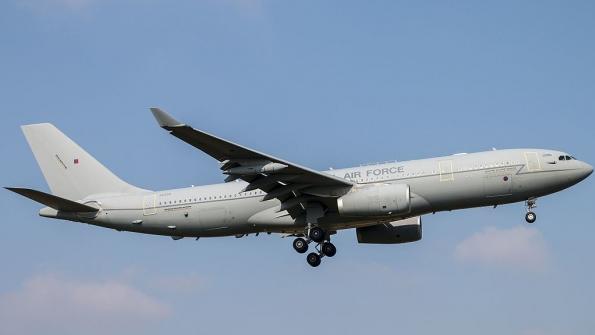
Airbus is developing a removable refueling boom for its A330 Multi-Role Tanker Transport (MRTT) to meet a requirement for the European Multinational Multi Role Tanker Transport Fleet (MMF).
Normally refueling booms are a permanent fixture on aerial refueling tankers. But the MMF is requesting a “boomless capability” for part of the currently planned eight-strong fleet which will support operations for Belgium, the Czech Republic, Germany, Luxembourg the Netherlands, and Norway. Airbus said the ability to remove the boom will add flexibility to the fleet, allowing operators to save weight and fuel when flying nonaerial refueling missions such as strategic transport, medical evacuation and government VIP flights.
Airbus is currently negotiating with the European defense materiel agency OCCAR to sign off on a contract amendment for the MMF fleet in the coming months, company officials told Aerospace DAILY.
Once the boom is removed fuel pipes are plugged, wiring is relocated, and a small fairing is fitted to cover where the boom was attached.
Airbus says the technology could be applied to all MRTTs. An obvious customer for the system could be the UK Royal Air Force, which purchased its MRTTs with only hose-drogue refueling systems fitted. Since the MRTT began entering frontline service in 2012, the British government has introduced several aircraft types which cannot be refueled by the A330s. They include the RC-135 Rivet Joint, the Boeing P-8 Poseidon maritime patrol aircraft and the Boeing E-7 Wedgetail airborne early warning platform, which the UK is planning to introduce in 2023.
Details of the MRTT boomless capability emerged in a press release by OCCAR released on May 4 about programmatic progress despite the COVID-19 pandemic. The boomless capacity is part of wider contract amendments which also include considering the acquisition of a ninth MRTT for the MMF fleet. Once the MMF fleet had grown to eight aircraft, OCCAR had options for an additional three aircraft, potentially allowing the fleet to grow to 11. The first MMF MRTT delivery is expected in June.
The MMF is based on a pooling and sharing arrangement between participating nations in which the countries join for a number of flying hours per year. This enables smaller nations that are unable to have a fleet of tanker aircraft of their own to get access to a refueling capability. In other words, nations join the MMF for half an aircraft and access to a fleet of eight. The aircraft will be owned by NATO and managed by the NATO Support and Procurement Agency.





